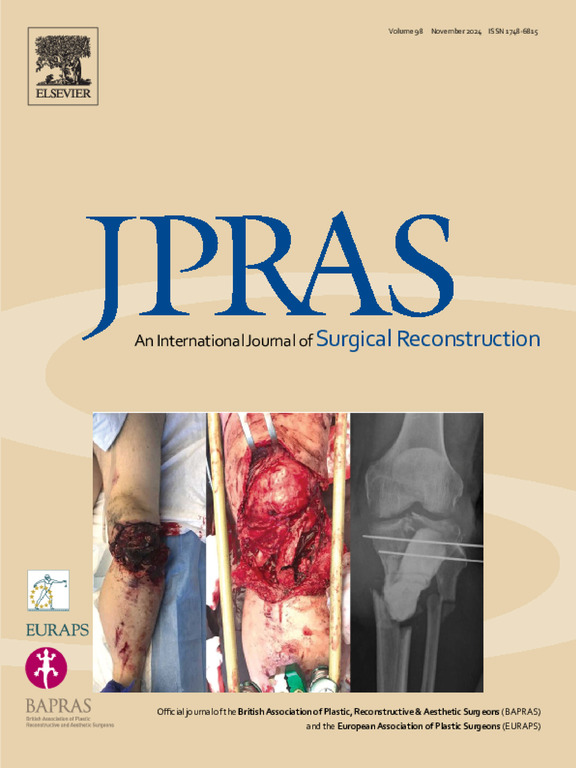Finite element analysis of donor site fracture risk after medial femoral condyle flap harvest: Implications for optimal harvest site and flap size
IF 2.4
3区 医学
Q2 SURGERY
Journal of Plastic Reconstructive and Aesthetic Surgery
Pub Date : 2025-08-18
DOI:10.1016/j.bjps.2025.08.005
引用次数: 0
Abstract
Background
This study aimed to evaluate the risk of fracture with weight-bearing after medial femoral condyle (MFC) harvest with varying harvest size and location using finite element analysis (FEA).
Methods
FEA evaluated the potential impact of MFC harvest on donor femur strength. Donor flaps were modeled as cubes of corticocancellous defects within the descending genicular angiosome (DGA). Stress and safety factors were recorded during simulated single-leg stance as a function of harvest size and location within the DGA. An S-N curve was used to determine the number of cycles to failure due to stress.
Results
Among the 15 simulated harvest size and location combinations for each femur, the smallest (1x1x1 cm) corticocancellous flap centered 1 cm proximal to the medial epicondyle demonstrated the most favorable stress (34.95±9.81 MPa), safety factor (3.42±0.85), and fatigue (>106 cycles) profiles during single-leg stance, but saw notably increased stress and lower safety factors at larger sizes. Flaps centered at the medial epicondyle and shifted 0.5 cm proximally exhibited consistent stress and safety factor values. The largest (2x2x2 cm) and most proximally based flap (2 cm proximal) resulted in a precipitous increase in stress (92.23±21.19 MPa) and fatigue profile (102–103 cycles).
Conclusions
Our results suggest that small corticocancellous flaps centered no more than 0.5 cm proximal to the medial epicondyle are the most favorable for harvest, resulting in physiologically tolerable stress values on the donor femur during single-leg stance. Caution and potential weight-bearing restrictions should be considered when harvesting larger and more proximally based flaps.
Level of evidence
Biomechanical study
股骨内侧髁瓣摘取后供区骨折风险的有限元分析:最佳摘取位置和皮瓣大小的意义
本研究旨在利用有限元分析(FEA)评估不同截骨尺寸和位置的股骨内侧髁(MFC)截骨后负重骨折的风险。方法采用有限元法评估MFC收获对供体股骨强度的潜在影响。供体皮瓣被建模为膝降血管体(DGA)内皮质松质缺陷的立方体。在模拟单腿站立期间,记录应力和安全系数作为收获大小和DGA内位置的函数。使用S-N曲线来确定由于应力而导致破坏的循环次数。结果单腿站立时,以内上髁近端1 cm为中心的最小皮质松质瓣(1x1x1 cm)具有最有利的应力(34.95±9.81 MPa)、安全系数(3.42±0.85)和疲劳(>;106个周期)特征,但较大尺寸时应力明显增加,安全系数较低。以内上髁为中心并向近端移动0.5 cm的皮瓣显示出一致的应力和安全系数值。最大(2x2x2 cm)和最近端的皮瓣(近端2cm)导致应力急剧增加(92.23±21.19 MPa)和疲劳剖面(102-103个循环)。结论单腿站立时,以内侧上髁近端不超过0.5 cm为中心的小皮质松质瓣最适合采集,可使供体股骨承受生理上可耐受的应力值。在采集更大、更近端的皮瓣时,应考虑到谨慎和潜在的承重限制。证据水平:生物力学研究
本文章由计算机程序翻译,如有差异,请以英文原文为准。
求助全文
约1分钟内获得全文
求助全文
来源期刊
CiteScore
3.10
自引率
11.10%
发文量
578
审稿时长
3.5 months
期刊介绍:
JPRAS An International Journal of Surgical Reconstruction is one of the world''s leading international journals, covering all the reconstructive and aesthetic aspects of plastic surgery.
The journal presents the latest surgical procedures with audit and outcome studies of new and established techniques in plastic surgery including: cleft lip and palate and other heads and neck surgery, hand surgery, lower limb trauma, burns, skin cancer, breast surgery and aesthetic surgery.

 求助内容:
求助内容: 应助结果提醒方式:
应助结果提醒方式:


